 Dr. Xiao Rongge
(Xiao bóshì)
is my research colleague and host while I'm in China.
Dr. Xiao Rongge
(Xiao bóshì)
is my research colleague and host while I'm in China. In China, we typically ate hot lunches and dinners at the university restaurant on campus. The campus is beautiful and the food is excellent!
 Waiters place the plates on a
large, round, glass turntable and the diners turn it to reach the food
they want (so you don't have to ask someone to pass the salt!).
Waiters place the plates on a
large, round, glass turntable and the diners turn it to reach the food
they want (so you don't have to ask someone to pass the salt!).  We ate solely with
chop
sticks (kua zi = sounds like
kw-eye dze [with schwa e] with strong accent on the kw-eye
syllable), which are very easy to get used to. Over time, I
watched
many
Chinese people use chop sticks and found there several different ways
to hold them - much like different people hold pencils
differently.
We ate solely with
chop
sticks (kua zi = sounds like
kw-eye dze [with schwa e] with strong accent on the kw-eye
syllable), which are very easy to get used to. Over time, I
watched
many
Chinese people use chop sticks and found there several different ways
to hold them - much like different people hold pencils
differently. Forks and knives were not an option in any restaurant we visited, so one either learns to use chopsticks, brings forks from home, or goes on a diet.
 There's a significant
difference between Chinese food in China and Chinese food in
America.
In China, the sauces are commonly more subtle, some meat dishes can be
more fatty, and
vegetables fresher and with a wider variety. The Chinese
appreciate
each
vegetable for its own characteristic flavor - whether it is sweet,
sour, bitter, etc.
Of
course, there are the odd little differences in the kinds of meat and
the presentation (e.g., goose head, donkey meat, etc.).
There's a significant
difference between Chinese food in China and Chinese food in
America.
In China, the sauces are commonly more subtle, some meat dishes can be
more fatty, and
vegetables fresher and with a wider variety. The Chinese
appreciate
each
vegetable for its own characteristic flavor - whether it is sweet,
sour, bitter, etc.
Of
course, there are the odd little differences in the kinds of meat and
the presentation (e.g., goose head, donkey meat, etc.)."Lazy Susan" turntables are common at bigger tables. Everyone shares all the dishes, instead of each person ordering a plate just for themselves like in America.
 This was one of the main cafeteria
for students at the university. A team of older women constantly
cleaned the stainless steel tables and mopped the floor. Students
ordered at the windows of the little kiosk selling the food style they
wanted and then paid using a prepaid card that they'd hold up to a
sensor. The sensor card is a great idea because then the food
servers never contaminate their hands with germs from handling money.
This was one of the main cafeteria
for students at the university. A team of older women constantly
cleaned the stainless steel tables and mopped the floor. Students
ordered at the windows of the little kiosk selling the food style they
wanted and then paid using a prepaid card that they'd hold up to a
sensor. The sensor card is a great idea because then the food
servers never contaminate their hands with germs from handling money.There are several of these places around campus and I found the food to be excellent in all of them. Only the Chinese would think to provide good food to students!
 Xiao Rongge (my colleague) and
Zach Artz (my student) together at lunch. Zach was given the
Chinese name Xiào hŭ (pronounced shao who = "little
tiger" = an affectionate name) and was a favorite with the Chinese
girls because of his curly hair and good looks.
Xiao Rongge (my colleague) and
Zach Artz (my student) together at lunch. Zach was given the
Chinese name Xiào hŭ (pronounced shao who = "little
tiger" = an affectionate name) and was a favorite with the Chinese
girls because of his curly hair and good looks.  Lisa
Ferguson (my student) and Fei HongCai (Xiao's Ph.D. student) at
lunch. Lisa was given the Chinese name A Jing (calm, peaceful, harmonious
person) because she's smart, but quiet about it. Fei HongCia
spoke English very well and was essential in communication within the
group, especially in the field later on.
Lisa
Ferguson (my student) and Fei HongCai (Xiao's Ph.D. student) at
lunch. Lisa was given the Chinese name A Jing (calm, peaceful, harmonious
person) because she's smart, but quiet about it. Fei HongCia
spoke English very well and was essential in communication within the
group, especially in the field later on. Wang
BingTing and Kristen Ward (my student) at lunch. Wang BingTing
studied oil geophysics, but was always welcome with me because she had
a truly extraordinarily positive outlook on life and excellent
person.
Wang
BingTing and Kristen Ward (my student) at lunch. Wang BingTing
studied oil geophysics, but was always welcome with me because she had
a truly extraordinarily positive outlook on life and excellent
person.  Dinners with students were always
fun. The students enjoyed using their skills speaking English and
really opened up to us. Really excellent people!
Dinners with students were always
fun. The students enjoyed using their skills speaking English and
really opened up to us. Really excellent people! Lisa,
Fei HongCai, and Kristen - half of the fieldwork group outside the
university restaurant. In the background, the debris in the field
is a common sight as the university (and most of Beijing) modernize
their buildings. Such modernization is considered a mixed
blessing. The famous hutongs
(the quaint, maze-like network of interconnected buildings and
alleyways that makes up the old part of town) are being taken down to
build modern high rise apartments, much to the chagrin of many
westerners. On one hand, little run-down brick shacks from which
poorer people sell fruits, vegetables, and clothing are a way for some
poor people to make a living. On the other hand, many of those
little shacks are in very bad shape, pretty dirty looking, and take up
precious space in a major city that's trying to keep up with the needs
of its people. I try to imagine what outcry there was when
downtown Manhattan in New York City took down older buildings to
construct the buildings that make up its famous modern skyline.
Would people today rather we have kept the dirty, little, one-story
shacks?
Lisa,
Fei HongCai, and Kristen - half of the fieldwork group outside the
university restaurant. In the background, the debris in the field
is a common sight as the university (and most of Beijing) modernize
their buildings. Such modernization is considered a mixed
blessing. The famous hutongs
(the quaint, maze-like network of interconnected buildings and
alleyways that makes up the old part of town) are being taken down to
build modern high rise apartments, much to the chagrin of many
westerners. On one hand, little run-down brick shacks from which
poorer people sell fruits, vegetables, and clothing are a way for some
poor people to make a living. On the other hand, many of those
little shacks are in very bad shape, pretty dirty looking, and take up
precious space in a major city that's trying to keep up with the needs
of its people. I try to imagine what outcry there was when
downtown Manhattan in New York City took down older buildings to
construct the buildings that make up its famous modern skyline.
Would people today rather we have kept the dirty, little, one-story
shacks?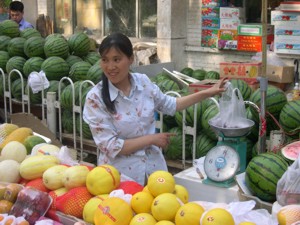 The university has a row of fruit
stands that sell excellent quality fruits and vegetables. They
also sell meats, but I had no way of cooking them, so I didn't try
those. Watermelon (known as "western melon"), lychee, and another
fruit (unknown name) were my favorites.
The university has a row of fruit
stands that sell excellent quality fruits and vegetables. They
also sell meats, but I had no way of cooking them, so I didn't try
those. Watermelon (known as "western melon"), lychee, and another
fruit (unknown name) were my favorites. 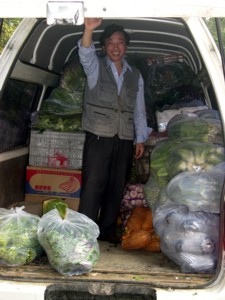 Fruit and vegetables were
delivered to the fruit stands from the back of a minivan like this
one. People in China are remarkably friendly to strangers like
me. Maybe that's just because I'm an unusual looking, big,
smiling American, but I don't know.
Fruit and vegetables were
delivered to the fruit stands from the back of a minivan like this
one. People in China are remarkably friendly to strangers like
me. Maybe that's just because I'm an unusual looking, big,
smiling American, but I don't know.  This
fellow had a portable heavy-duty sewing machine for fixing shoes,
etc.
Guys like this were fairly common alongside the streets. Some
fixed
bikes, others sewed, and others made keys, etc.
This
fellow had a portable heavy-duty sewing machine for fixing shoes,
etc.
Guys like this were fairly common alongside the streets. Some
fixed
bikes, others sewed, and others made keys, etc. This woman cooked long doughnuts
in a big wok. Little shops like this are common along back
alleyways.
This woman cooked long doughnuts
in a big wok. Little shops like this are common along back
alleyways.  This old fellow hauled bricks for
construction using this wheelbarrow all day. He was a tough
little guy!
This old fellow hauled bricks for
construction using this wheelbarrow all day. He was a tough
little guy! 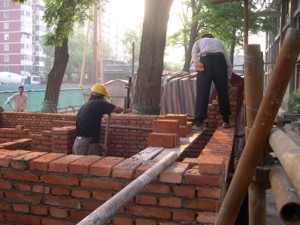 The bricks that fellow hauled were
used to make a small building near the dorms. Bricklayers dressed
in pretty nice clothes for their work - not holey jeans and stained
T-shirts one sometimes sees elsewhere in the world.
The bricks that fellow hauled were
used to make a small building near the dorms. Bricklayers dressed
in pretty nice clothes for their work - not holey jeans and stained
T-shirts one sometimes sees elsewhere in the world.  A lot of construction involves
some heavy lifting. The Chinese are masters with a lever!
A lot of construction involves
some heavy lifting. The Chinese are masters with a lever! Construction
is hard work - here, some workers rest after a lunch during a long,
hard day of hauling concrete blocks, digging with picks and shovels,
etc. Taking a short rest after lunch was common in China, as it
is in many other parts of the world (e.g., siestas in Latin
America).
Construction
is hard work - here, some workers rest after a lunch during a long,
hard day of hauling concrete blocks, digging with picks and shovels,
etc. Taking a short rest after lunch was common in China, as it
is in many other parts of the world (e.g., siestas in Latin
America).  Daily
exercise is a big deal for the Chinese. This was a little
exercise
plaza for the people living in the surrounding apartment
buildings.
The exercise equipment was similar to what one might find in an
American gym, but more robust so that it didn't require a lot of
maintenance.
Daily
exercise is a big deal for the Chinese. This was a little
exercise
plaza for the people living in the surrounding apartment
buildings.
The exercise equipment was similar to what one might find in an
American gym, but more robust so that it didn't require a lot of
maintenance.  Basketball
is very, very popular with students. Cai ZhiHui - a brilliant
young
geologist - was very competitive on the court. Contrary to
western
stereotypes of Chinese people, there are a fair number of tall Chinese
and the number of students I see that are taller than I am grows every
year that I go (I'm 6'2" or 188 cm).
Basketball
is very, very popular with students. Cai ZhiHui - a brilliant
young
geologist - was very competitive on the court. Contrary to
western
stereotypes of Chinese people, there are a fair number of tall Chinese
and the number of students I see that are taller than I am grows every
year that I go (I'm 6'2" or 188 cm).
 Exercise
groups like this were popular in the morning. Some used red fans
(seen
here), others had swords with tassels, and still others were just empty
handed. Their coordinated movement was really very beautiful to
watch.
Exercise
groups like this were popular in the morning. Some used red fans
(seen
here), others had swords with tassels, and still others were just empty
handed. Their coordinated movement was really very beautiful to
watch. Bicycles
are the most common way to get around for short distances. Most
bikes
are pretty drab-looking things. Chinese intentionally choose
bikes
that look beat up so that their bikes don't get stolen. Brand
new,
brightly painted bikes are extremely rare.
Bicycles
are the most common way to get around for short distances. Most
bikes
are pretty drab-looking things. Chinese intentionally choose
bikes
that look beat up so that their bikes don't get stolen. Brand
new,
brightly painted bikes are extremely rare. Beijing has a good bus and train system for going longer distances, as well as plenty of taxis. Traffic is insane, so I wouldn't want to drive a car myself, but that's pretty common in many parts of the world. For example, I wouldn't want to drive in the city in Indonesia, Italy, or Mexico, either.

 My three students with Xiao at a
hot pot dinner. Hot pot is similar to fondue, except the raw meat
is shaved very thin and cooked in boiling broths instead of oil.
Some of the broths can be quite spicy! All were very delicious!
My three students with Xiao at a
hot pot dinner. Hot pot is similar to fondue, except the raw meat
is shaved very thin and cooked in boiling broths instead of oil.
Some of the broths can be quite spicy! All were very delicious!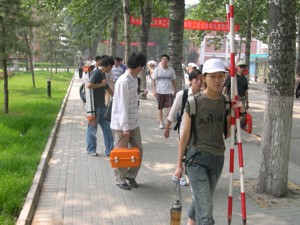
 Students at the China University
of Geosciences get excellent hands-on training in geology.
Students like these were always practicing surveying the campus.
The university even has a small drilling derrick for students to
practice drilling oil wells!
Students at the China University
of Geosciences get excellent hands-on training in geology.
Students like these were always practicing surveying the campus.
The university even has a small drilling derrick for students to
practice drilling oil wells!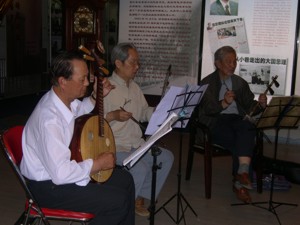 I
found these three fellows practicing playing music using
traditional Chinese instruments. Their skill was really very
impressive and their music wonderful to hear! I was particularly
interested in watching the fellows with the bowed instruments (the
fellow on the right is playing a 2-stringed erhu). Like a western
violin/fiddle, these instruments do not have frets, so the fingers on
the left hand must know precisely where to go!
I
found these three fellows practicing playing music using
traditional Chinese instruments. Their skill was really very
impressive and their music wonderful to hear! I was particularly
interested in watching the fellows with the bowed instruments (the
fellow on the right is playing a 2-stringed erhu). Like a western
violin/fiddle, these instruments do not have frets, so the fingers on
the left hand must know precisely where to go!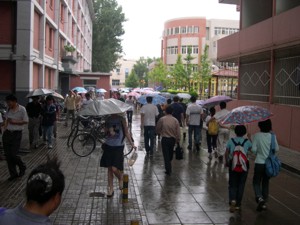
 Chinese people in Beijing always
seem to be prepared for the relatively rare rain. Umbrellas
double as parasols on hot days.
Chinese people in Beijing always
seem to be prepared for the relatively rare rain. Umbrellas
double as parasols on hot days. 
 Cranes are a very common sight on
the Beijing skyline. I can't think of a day touring around in
Beijing that I didn't see at least a dozen cranes like this.
Cranes are a very common sight on
the Beijing skyline. I can't think of a day touring around in
Beijing that I didn't see at least a dozen cranes like this.
 Most Chinese people in Beijing
appear to live in apartment buildings like this one. Single
family houses might exist, but they must be in suburbs far from the
city.
Most Chinese people in Beijing
appear to live in apartment buildings like this one. Single
family houses might exist, but they must be in suburbs far from the
city.  Street signs, of course, are
written in Chinese characters. Many signs that give directions to
drivers, though, are also marked in pinyin (the alphabetic spellings of
words westerners are more familiar with).
Street signs, of course, are
written in Chinese characters. Many signs that give directions to
drivers, though, are also marked in pinyin (the alphabetic spellings of
words westerners are more familiar with).
 This little guy followed me around
for a while one day taking notes. Whenever I'd look over at him,
he'd quickly look away or look down at his notes. I think he was
playing a game with me. Either that, or the Chinese intelligence
agency has some very young recruits!
This little guy followed me around
for a while one day taking notes. Whenever I'd look over at him,
he'd quickly look away or look down at his notes. I think he was
playing a game with me. Either that, or the Chinese intelligence
agency has some very young recruits! My students insisted on taking my
photo by an ice cream shop since I'm apparently known for always
stopping for ice cream on the way back from fieldtrips back in
America. Everyone has their vices, I suppose. Ice cream
shops are extremely rare in China since the Chinese don't eat a lot of
dairy products. Standard milk is out of the question because many
people are lactose intolerant. Yogurt drink is the most common
dairy product and is not at all common.
My students insisted on taking my
photo by an ice cream shop since I'm apparently known for always
stopping for ice cream on the way back from fieldtrips back in
America. Everyone has their vices, I suppose. Ice cream
shops are extremely rare in China since the Chinese don't eat a lot of
dairy products. Standard milk is out of the question because many
people are lactose intolerant. Yogurt drink is the most common
dairy product and is not at all common. 
 Being a Traffic fan, I couldn't help but try
eating at a "Beijing noodle factory." This place was fun because
they all shouted hello to each customer when they entered. There
was a lot of shouting and ceremony with each serving. The bowls
of noodles were served with about six other ingredients, each brought
out in separate little porcelain bowls and then mixed wildly at the
table for each customer.
Being a Traffic fan, I couldn't help but try
eating at a "Beijing noodle factory." This place was fun because
they all shouted hello to each customer when they entered. There
was a lot of shouting and ceremony with each serving. The bowls
of noodles were served with about six other ingredients, each brought
out in separate little porcelain bowls and then mixed wildly at the
table for each customer. Eating noodles with chopsticks can
be a little tricky, as Zach demonstrates. The food was very good,
though, as usual!
Eating noodles with chopsticks can
be a little tricky, as Zach demonstrates. The food was very good,
though, as usual!
 I like to see when cooks eat their
own food. After the rush and most of the other tourists left, the
workers all came out and had their lunch.
I like to see when cooks eat their
own food. After the rush and most of the other tourists left, the
workers all came out and had their lunch.  The train station in Beijing was a
busy place. This was the arrival/departure board as we waited for
our night train to Hohaohete, Nei Mengu (Hohhot, Inner Mongolia).
The train station in Beijing was a
busy place. This was the arrival/departure board as we waited for
our night train to Hohaohete, Nei Mengu (Hohhot, Inner Mongolia).
